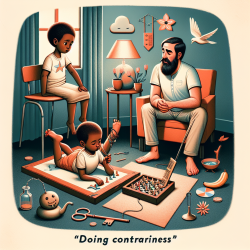As practitioners in the field of child therapy, our primary goal is to foster environments where children feel understood and supported. A recent study titled "Doing Contrariness: Therapeutic Talk-In-Interaction in a Single Therapy Session With a Traumatized Child" offers valuable insights into how therapeutic conversations can be optimized to achieve better outcomes. The study employs conversation analysis (CA) to dissect interactions within a therapy session, providing us with actionable strategies to enhance our therapeutic practices.
The research focuses on a single case study involving a 4-year-old adopted girl exhibiting "unexplainable rage." Through detailed interaction analysis, the study identifies a key conversational practice termed "doing contrariness" (DC). This practice involves the child disrupting conversational norms, which can either aid or impede the therapeutic process depending on how it is managed.
Key Findings and Applications
- Establishing Empathy: The study highlights that empathy must be preceded by efforts to identify which type of individualized conversation works best with each child. This aligns with findings from adult psychotherapy, where therapists often "invent" a new therapy for each patient.
- Understanding Child Expressions: Children express conflicts and issues in ways that adults may find difficult to interpret. Play activities, such as using dolls, can open up additional scenarios for interaction, helping to disclose underlying problems masked in everyday interactions.
- Managing Vulnerability: The child's higher degree of vulnerability compared to adults requires sensitive handling. The study shows how "avoiding doing contrariness" (ADC) and "remedying contrariness" (RDC) can preserve or restore the affiliative dimension of the therapeutic relationship.
Implementing the Findings
To integrate these findings into practice, consider the following strategies:
- Adapt Conversational Conventions: Modify conversational practices to suit the child's individual needs. For instance, using play scenarios to negotiate and resolve conflicts can be highly effective.
- Preemptive Empathy: Before attempting to achieve empathy, invest time in understanding the child's unique way of communicating. This might involve observing their play and noting any references to unformulated grievances or conflicts.
- Handle Contrariness with Care: When a child exhibits contrariness, such as refusing to say goodbye to a parent, address it gently. Instead of direct confrontation, use creative solutions to avoid further affiliative damage.
Encouraging Further Research
While this study provides a robust framework for understanding and managing contrariness in child therapy, it also opens the door for further research. Practitioners are encouraged to explore additional case studies and apply conversation analysis to different therapeutic contexts. This will help to refine and expand the strategies for achieving better therapeutic outcomes.
To read the original research paper, please follow this link: Doing Contrariness: Therapeutic Talk-In-Interaction in a Single Therapy Session With a Traumatized Child.










